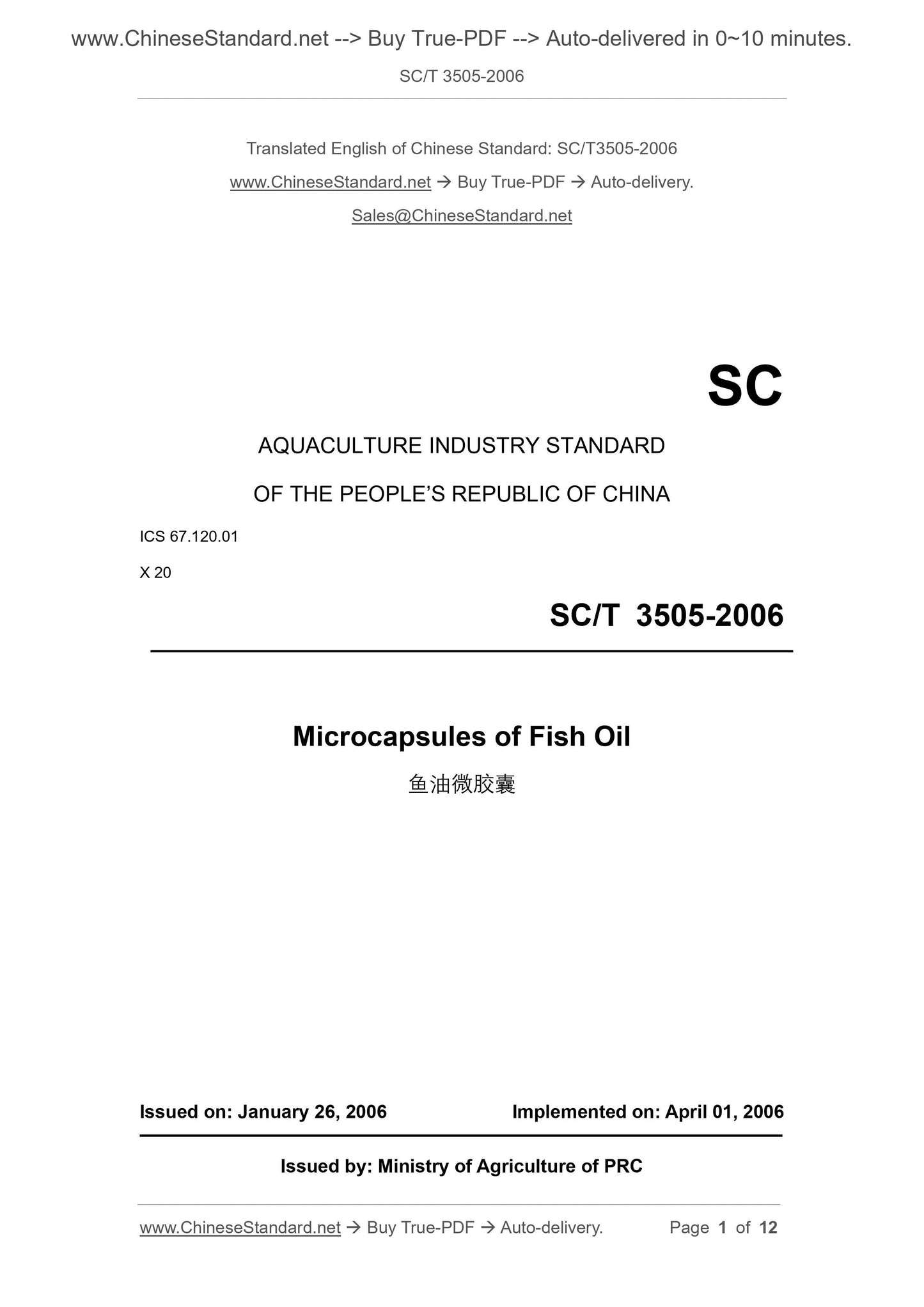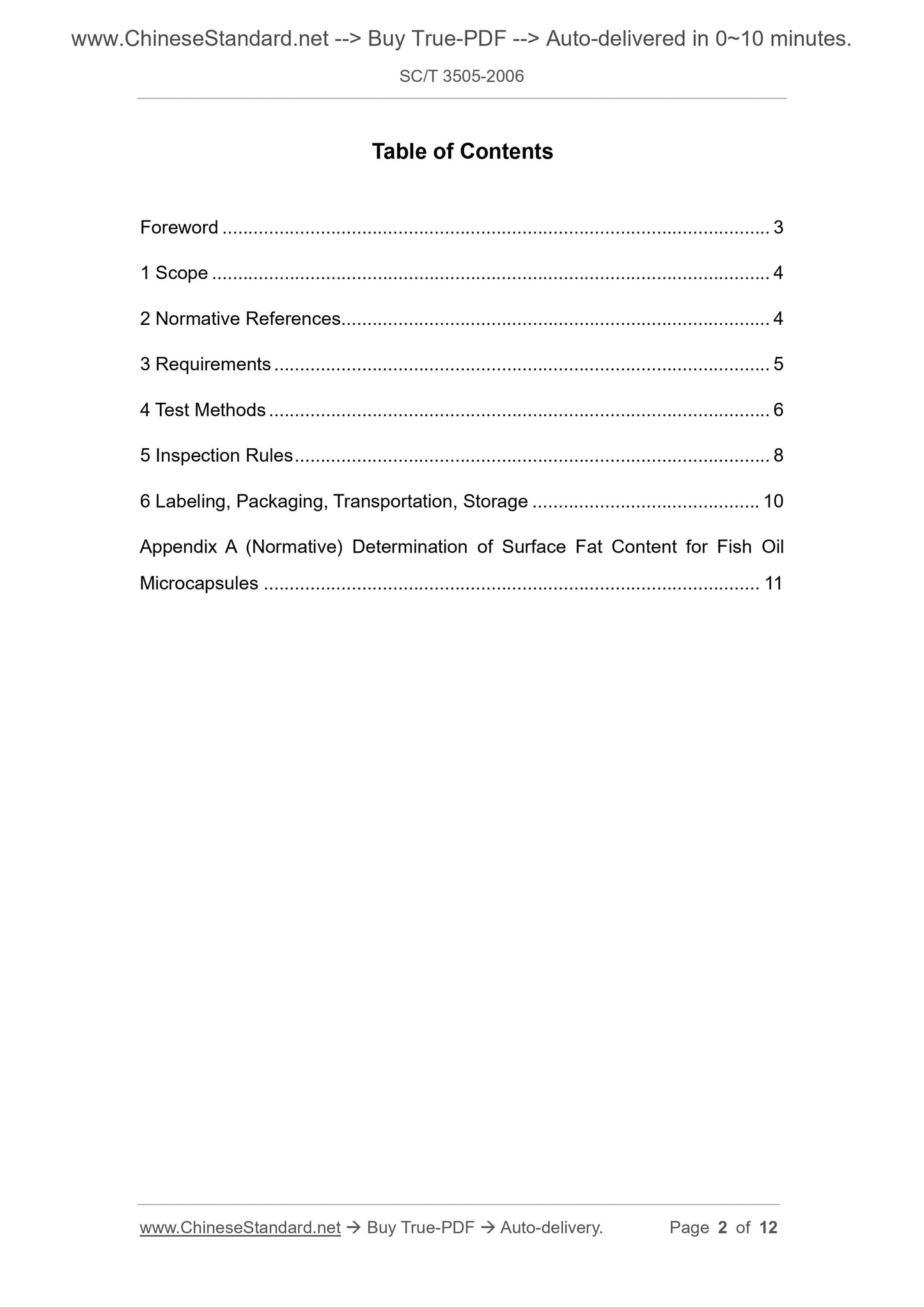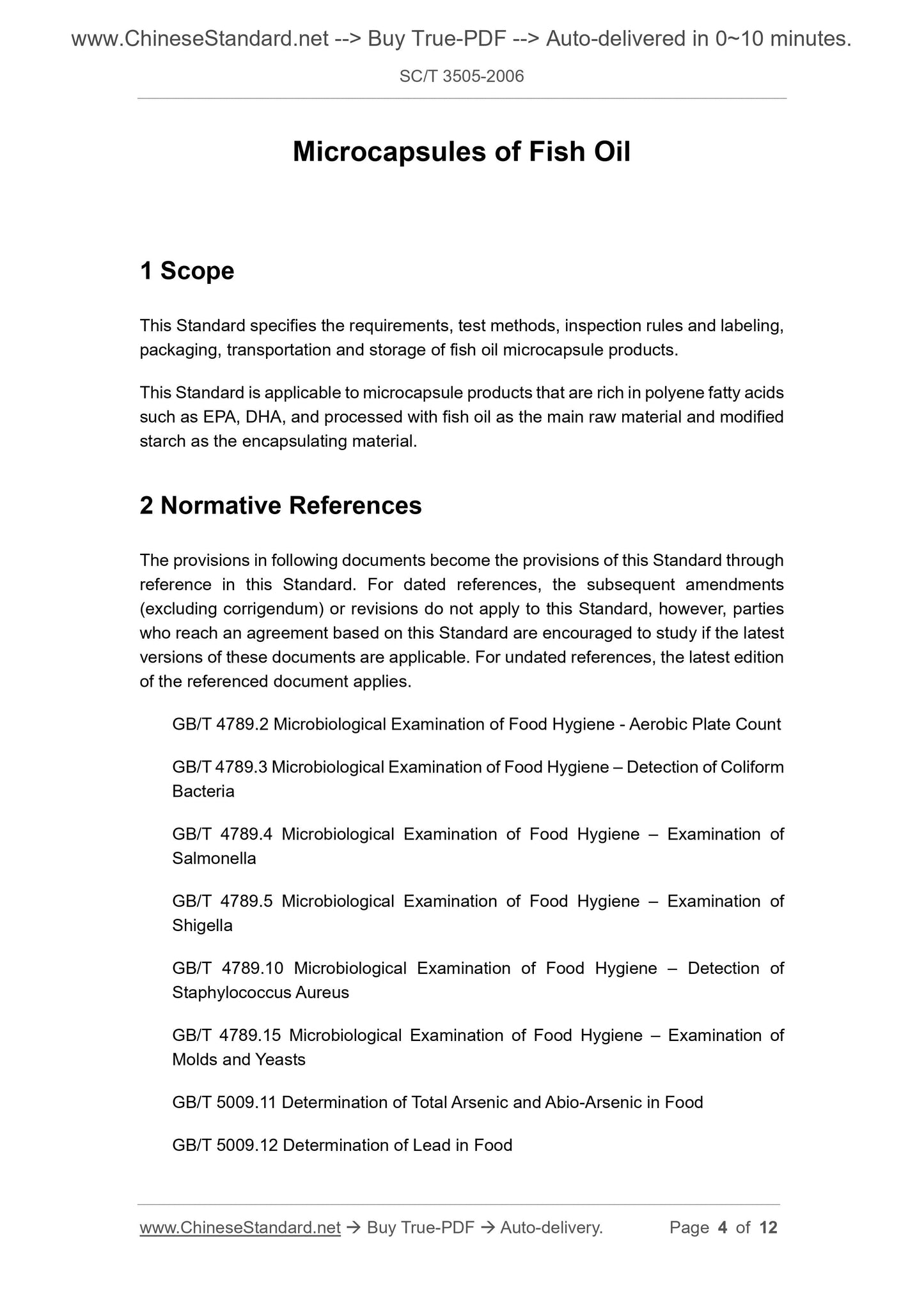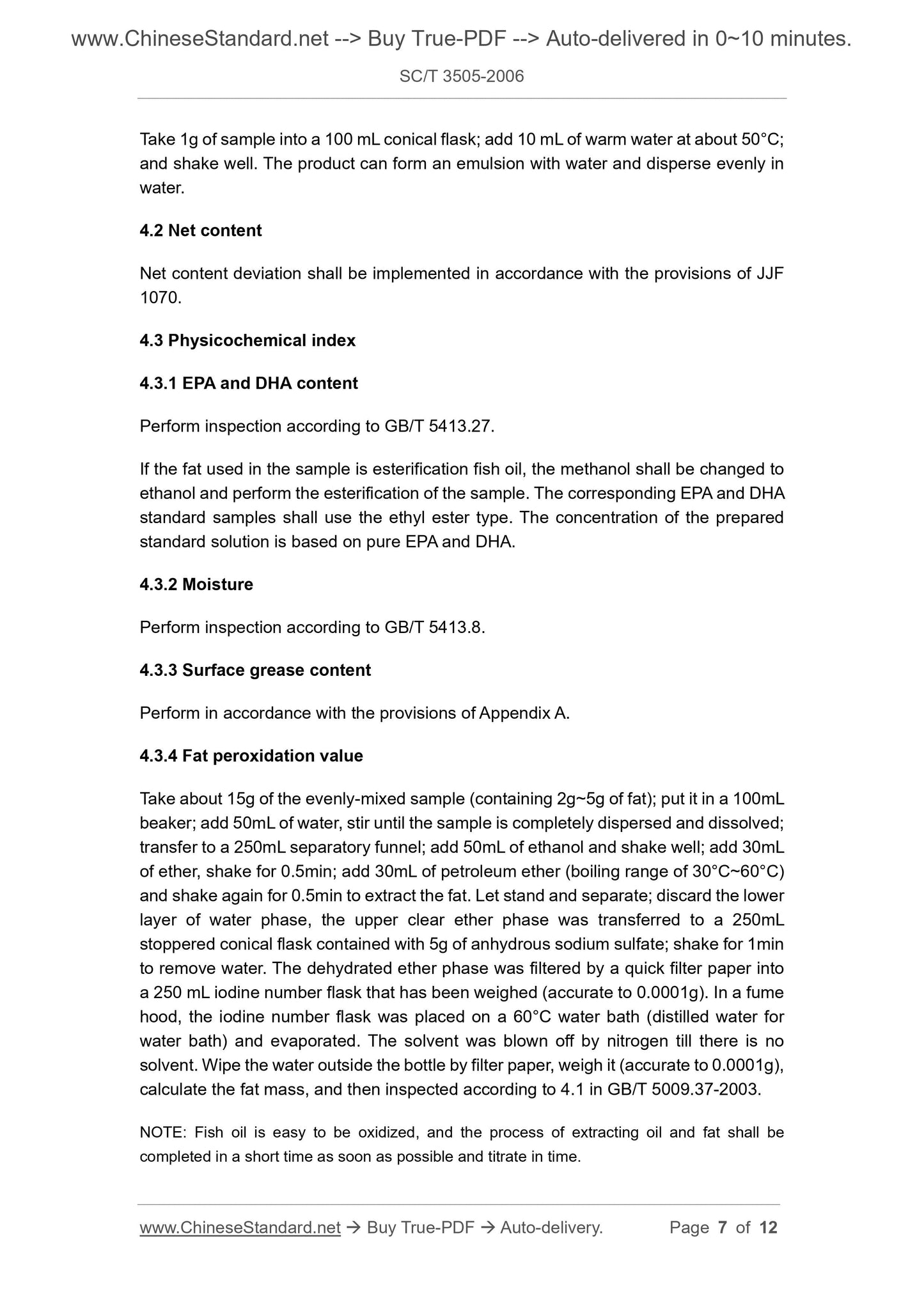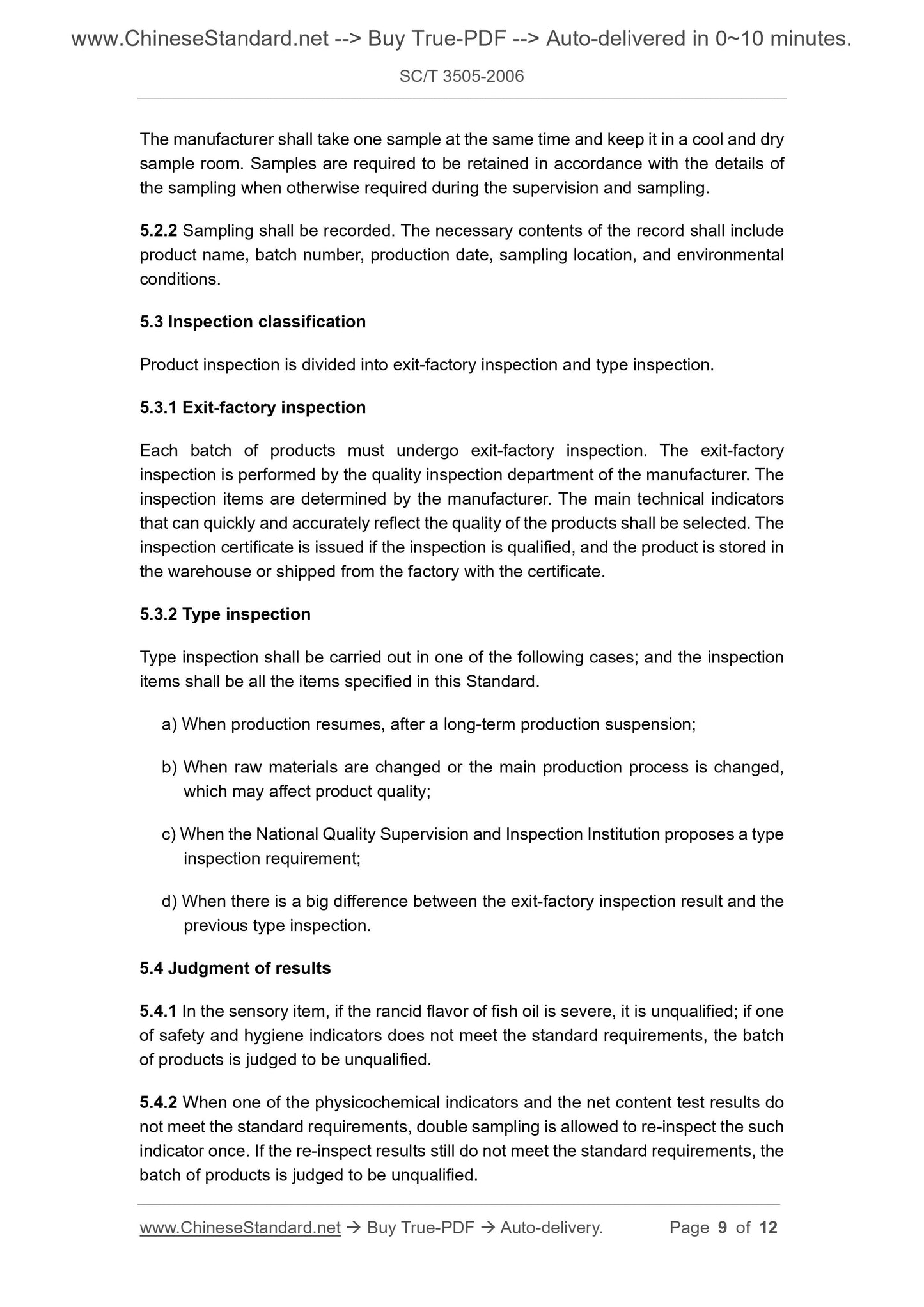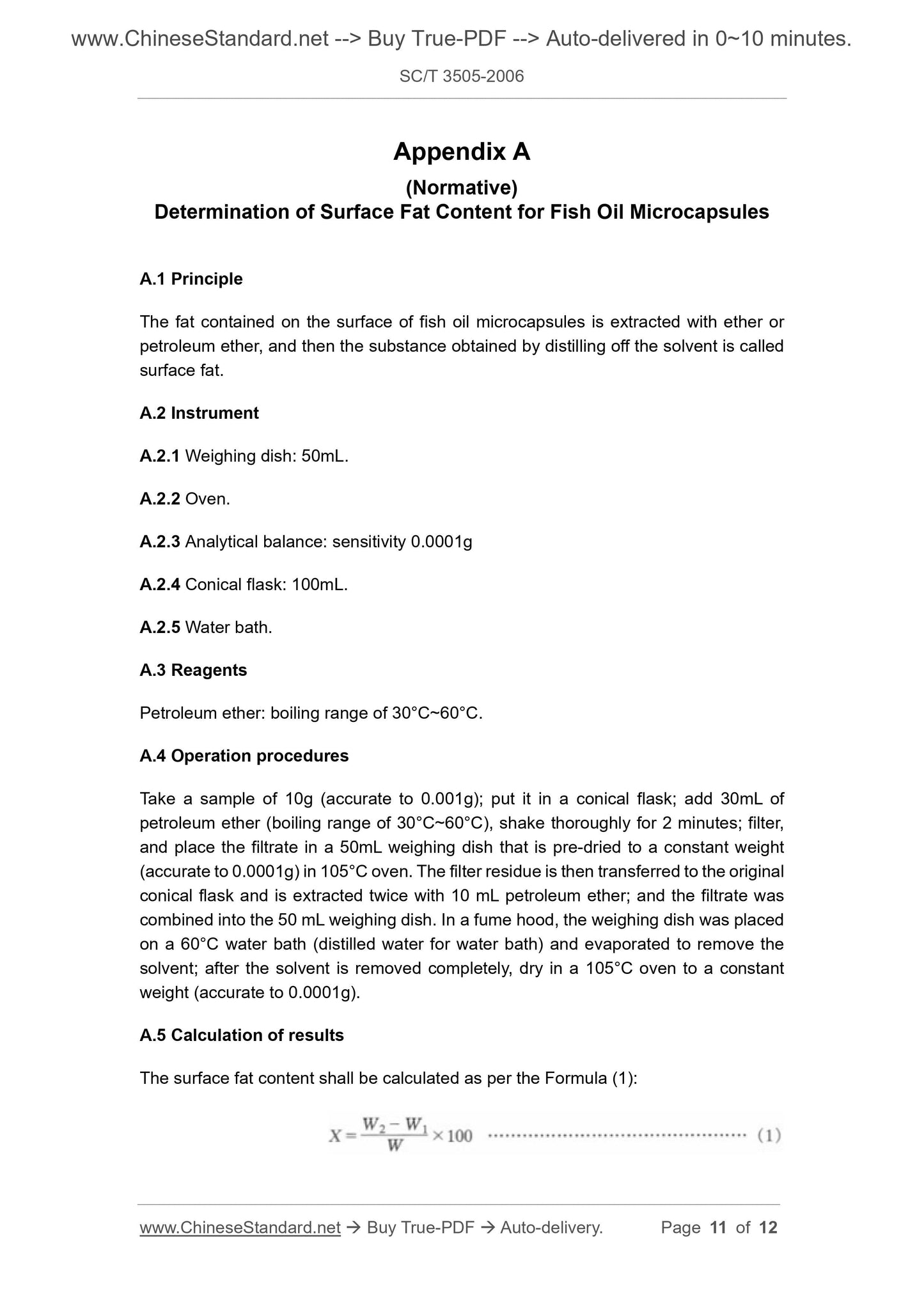1
/
of
6
PayPal, credit cards. Download editable-PDF and invoice in 1 second!
SC/T 3505-2006 English PDF (SCT3505-2006)
SC/T 3505-2006 English PDF (SCT3505-2006)
Regular price
$70.00 USD
Regular price
Sale price
$70.00 USD
Unit price
/
per
Shipping calculated at checkout.
Couldn't load pickup availability
Delivery: 3 seconds. Download true-PDF + Invoice.
Get QUOTATION in 1-minute: Click SC/T 3505-2006
Historical versions: SC/T 3505-2006
Preview True-PDF (Reload/Scroll if blank)
SC/T 3505-2006: Microcapsules of fish oil
SC/T 3505-2006
AQUACULTURE INDUSTRY STANDARD
OF THE PEOPLE’S REPUBLIC OF CHINA
ICS 67.120.01
X 20
Microcapsules of Fish Oil
鱼油微胶囊
ISSUED ON: JANUARY 26, 2006
IMPLEMENTED ON: APRIL 01, 2006
Issued by: Ministry of Agriculture of PRC
Table of Contents
Foreword ... 3
1 Scope ... 4
2 Normative References ... 4
3 Requirements ... 5
4 Test Methods ... 6
5 Inspection Rules ... 8
6 Labeling, Packaging, Transportation, Storage ... 10
Appendix A (Normative) Determination of Surface Fat Content for Fish Oil
Microcapsules ... 11
Microcapsules of Fish Oil
1 Scope
This Standard specifies the requirements, test methods, inspection rules and labeling,
packaging, transportation and storage of fish oil microcapsule products.
This Standard is applicable to microcapsule products that are rich in polyene fatty acids
such as EPA, DHA, and processed with fish oil as the main raw material and modified
starch as the encapsulating material.
2 Normative References
The provisions in following documents become the provisions of this Standard through
reference in this Standard. For dated references, the subsequent amendments
(excluding corrigendum) or revisions do not apply to this Standard, however, parties
who reach an agreement based on this Standard are encouraged to study if the latest
versions of these documents are applicable. For undated references, the latest edition
of the referenced document applies.
GB/T 4789.2 Microbiological Examination of Food Hygiene - Aerobic Plate Count
GB/T 4789.3 Microbiological Examination of Food Hygiene – Detection of Coliform
Bacteria
GB/T 4789.4 Microbiological Examination of Food Hygiene – Examination of
Salmonella
GB/T 4789.5 Microbiological Examination of Food Hygiene – Examination of
Shigella
GB/T 4789.10 Microbiological Examination of Food Hygiene – Detection of
Staphylococcus Aureus
GB/T 4789.15 Microbiological Examination of Food Hygiene – Examination of
Molds and Yeasts
GB/T 5009.11 Determination of Total Arsenic and Abio-Arsenic in Food
GB/T 5009.12 Determination of Lead in Food
Take 1g of sample into a 100 mL conical flask; add 10 mL of warm water at about 50°C;
and shake well. The product can form an emulsion with water and disperse evenly in
water.
4.2 Net content
Net content deviation shall be implemented in accordance with the provisions of JJF
1070.
4.3 Physicochemical index
4.3.1 EPA and DHA content
Perform inspection according to GB/T 5413.27.
If the fat used in the sample is esterification fish oil, the methanol shall be changed to
ethanol and perform the esterification of the sample. The corresponding EPA and DHA
standard samples shall use the ethyl ester type. The concentration of the prepared
standard solution is based on pure EPA and DHA.
4.3.2 Moisture
Perform inspection according to GB/T 5413.8.
4.3.3 Surface grease content
Perform in accordance with the provisions of Appendix A.
4.3.4 Fat peroxidation value
Take about 15g of the evenly-mixed sample (containing 2g~5g of fat); put it in a 100mL
beaker; add 50mL of water, stir until the sample is completely dispersed and dissolved;
transfer to a 250mL separatory funnel; add 50mL of ethanol and shake well; add 30mL
of ether, shake for 0.5min; add 30mL of petroleum ether (boiling range of 30°C~60°C)
and shake again for 0.5min to extract the fat. Let stand and separate; discard the lower
layer of water phase, the upper clear ether phase was transferred to a 250mL
stoppered conical flask contained with 5g of anhydrous sodium sulfate; shake for 1min
to remove water. The dehydrated ether phase was filtered by a quick filter paper into
a 250 mL iodine number flask that has been weighed (accurate to 0.0001g). In a fume
hood, the iodine number flask was placed on a 60°C water bath (distilled water for
water bath) and evaporated. The solvent was blown off by nitrogen till there is no
solvent. Wipe the water outside the bottle by filter paper, weigh it (accurate to 0.0001g),
calculate the fat mass, and then inspected according to 4.1 in GB/T 5009.37-2003.
NOTE: Fish oil is easy to be oxidized, and the process of extracting oil and fat shall be
completed in a short time as soon as possible and titrate in time.
The manufacturer shall take one sample at the same time and keep it in a cool and dry
sample room. Samples are required to be retained in accordance with the details of
the sampling when otherwise required during the supervision and sampling.
5.2.2 Sampling shall be recorded. The necessary contents of the record shall include
product name, batch number, production date, sampling location, and environmental
conditions.
5.3 Inspection classification
Product inspection is divided into exit-factory inspection and type inspection.
5.3.1 Exit-factory inspection
Each batch of products must undergo exit-factory inspection. The exit-factory
inspection is performed by the quality inspection department of the manufacturer. The
inspection items are determined by the manufacturer. The main technical indicators
that can quickly and accurately reflect the quality of the products shall be selected. The
inspection certificate is issued if the inspection is qualified, and the product is stored in
the warehouse or shipped from the factory with the certificate.
5.3.2 Type inspection
Type inspection shall be carried out in one of the following cases; and the inspection
items shall be all the items specified in this Standard.
a) When production resumes, after a long-term production suspension;
b) When raw materials are changed or the main production process is changed,
which may affect product quality;
c) When the National Quality Supervision and Inspection Institution proposes a type
inspection requirement;
d) When there is a big difference between the exit-factory inspection result and the
previous type inspection.
5.4 Judgment of results
5.4.1 In the sensory item, if the rancid flavor of fish oil is severe, it is unqualified; if one
of safety and hygiene indicators does not meet the standard requirements, the batch
of products is judged to be unqualified.
5.4.2 When one of the physicochemical indicators and the net content test results do
not meet the standard requirements, double sampling is allowed to re-inspect the such
indicator once. If the re-inspect results still do not meet the standard requirements, the
batch of products is judged to be unqualified.
Appendix A
(Normative)
Determination of Surface Fat Content for Fish Oil Microcapsules
A.1 Principle
The fat contained on the surface of fish oil microcapsules is extracted with ether or
petroleum ether, and then the substance obtained by distilling off the solvent is called
surface fat.
A.2 Instrument
A.2.1 Weighing dish: 50mL.
A.2.2 Oven.
A.2.3 Analytical balance: sensitivity 0.0001g
A.2.4 Conical flask: 100mL.
A.2.5 Water bath.
A.3 Reagents
Petroleum ether: boiling range of 30°C~60°C.
A.4 Operation procedures
Take a sample of 10g (accurate to 0.001g); put it in a conical flask; add 30mL of
petroleum ether (boiling range of 30°C~60°C), shake thoroughly for 2 minutes; filter,
and place the filtrate in a 50mL weighing dish that is pre-dried to a constant weight
(accurate to 0.0001g) in 105°C oven. The filter residue is then transferred to the original
conical flask and is extracted twice with 10 mL petroleum ether; and the filtrate was
combined into the 50 mL weighing dish. In a ...
Get QUOTATION in 1-minute: Click SC/T 3505-2006
Historical versions: SC/T 3505-2006
Preview True-PDF (Reload/Scroll if blank)
SC/T 3505-2006: Microcapsules of fish oil
SC/T 3505-2006
AQUACULTURE INDUSTRY STANDARD
OF THE PEOPLE’S REPUBLIC OF CHINA
ICS 67.120.01
X 20
Microcapsules of Fish Oil
鱼油微胶囊
ISSUED ON: JANUARY 26, 2006
IMPLEMENTED ON: APRIL 01, 2006
Issued by: Ministry of Agriculture of PRC
Table of Contents
Foreword ... 3
1 Scope ... 4
2 Normative References ... 4
3 Requirements ... 5
4 Test Methods ... 6
5 Inspection Rules ... 8
6 Labeling, Packaging, Transportation, Storage ... 10
Appendix A (Normative) Determination of Surface Fat Content for Fish Oil
Microcapsules ... 11
Microcapsules of Fish Oil
1 Scope
This Standard specifies the requirements, test methods, inspection rules and labeling,
packaging, transportation and storage of fish oil microcapsule products.
This Standard is applicable to microcapsule products that are rich in polyene fatty acids
such as EPA, DHA, and processed with fish oil as the main raw material and modified
starch as the encapsulating material.
2 Normative References
The provisions in following documents become the provisions of this Standard through
reference in this Standard. For dated references, the subsequent amendments
(excluding corrigendum) or revisions do not apply to this Standard, however, parties
who reach an agreement based on this Standard are encouraged to study if the latest
versions of these documents are applicable. For undated references, the latest edition
of the referenced document applies.
GB/T 4789.2 Microbiological Examination of Food Hygiene - Aerobic Plate Count
GB/T 4789.3 Microbiological Examination of Food Hygiene – Detection of Coliform
Bacteria
GB/T 4789.4 Microbiological Examination of Food Hygiene – Examination of
Salmonella
GB/T 4789.5 Microbiological Examination of Food Hygiene – Examination of
Shigella
GB/T 4789.10 Microbiological Examination of Food Hygiene – Detection of
Staphylococcus Aureus
GB/T 4789.15 Microbiological Examination of Food Hygiene – Examination of
Molds and Yeasts
GB/T 5009.11 Determination of Total Arsenic and Abio-Arsenic in Food
GB/T 5009.12 Determination of Lead in Food
Take 1g of sample into a 100 mL conical flask; add 10 mL of warm water at about 50°C;
and shake well. The product can form an emulsion with water and disperse evenly in
water.
4.2 Net content
Net content deviation shall be implemented in accordance with the provisions of JJF
1070.
4.3 Physicochemical index
4.3.1 EPA and DHA content
Perform inspection according to GB/T 5413.27.
If the fat used in the sample is esterification fish oil, the methanol shall be changed to
ethanol and perform the esterification of the sample. The corresponding EPA and DHA
standard samples shall use the ethyl ester type. The concentration of the prepared
standard solution is based on pure EPA and DHA.
4.3.2 Moisture
Perform inspection according to GB/T 5413.8.
4.3.3 Surface grease content
Perform in accordance with the provisions of Appendix A.
4.3.4 Fat peroxidation value
Take about 15g of the evenly-mixed sample (containing 2g~5g of fat); put it in a 100mL
beaker; add 50mL of water, stir until the sample is completely dispersed and dissolved;
transfer to a 250mL separatory funnel; add 50mL of ethanol and shake well; add 30mL
of ether, shake for 0.5min; add 30mL of petroleum ether (boiling range of 30°C~60°C)
and shake again for 0.5min to extract the fat. Let stand and separate; discard the lower
layer of water phase, the upper clear ether phase was transferred to a 250mL
stoppered conical flask contained with 5g of anhydrous sodium sulfate; shake for 1min
to remove water. The dehydrated ether phase was filtered by a quick filter paper into
a 250 mL iodine number flask that has been weighed (accurate to 0.0001g). In a fume
hood, the iodine number flask was placed on a 60°C water bath (distilled water for
water bath) and evaporated. The solvent was blown off by nitrogen till there is no
solvent. Wipe the water outside the bottle by filter paper, weigh it (accurate to 0.0001g),
calculate the fat mass, and then inspected according to 4.1 in GB/T 5009.37-2003.
NOTE: Fish oil is easy to be oxidized, and the process of extracting oil and fat shall be
completed in a short time as soon as possible and titrate in time.
The manufacturer shall take one sample at the same time and keep it in a cool and dry
sample room. Samples are required to be retained in accordance with the details of
the sampling when otherwise required during the supervision and sampling.
5.2.2 Sampling shall be recorded. The necessary contents of the record shall include
product name, batch number, production date, sampling location, and environmental
conditions.
5.3 Inspection classification
Product inspection is divided into exit-factory inspection and type inspection.
5.3.1 Exit-factory inspection
Each batch of products must undergo exit-factory inspection. The exit-factory
inspection is performed by the quality inspection department of the manufacturer. The
inspection items are determined by the manufacturer. The main technical indicators
that can quickly and accurately reflect the quality of the products shall be selected. The
inspection certificate is issued if the inspection is qualified, and the product is stored in
the warehouse or shipped from the factory with the certificate.
5.3.2 Type inspection
Type inspection shall be carried out in one of the following cases; and the inspection
items shall be all the items specified in this Standard.
a) When production resumes, after a long-term production suspension;
b) When raw materials are changed or the main production process is changed,
which may affect product quality;
c) When the National Quality Supervision and Inspection Institution proposes a type
inspection requirement;
d) When there is a big difference between the exit-factory inspection result and the
previous type inspection.
5.4 Judgment of results
5.4.1 In the sensory item, if the rancid flavor of fish oil is severe, it is unqualified; if one
of safety and hygiene indicators does not meet the standard requirements, the batch
of products is judged to be unqualified.
5.4.2 When one of the physicochemical indicators and the net content test results do
not meet the standard requirements, double sampling is allowed to re-inspect the such
indicator once. If the re-inspect results still do not meet the standard requirements, the
batch of products is judged to be unqualified.
Appendix A
(Normative)
Determination of Surface Fat Content for Fish Oil Microcapsules
A.1 Principle
The fat contained on the surface of fish oil microcapsules is extracted with ether or
petroleum ether, and then the substance obtained by distilling off the solvent is called
surface fat.
A.2 Instrument
A.2.1 Weighing dish: 50mL.
A.2.2 Oven.
A.2.3 Analytical balance: sensitivity 0.0001g
A.2.4 Conical flask: 100mL.
A.2.5 Water bath.
A.3 Reagents
Petroleum ether: boiling range of 30°C~60°C.
A.4 Operation procedures
Take a sample of 10g (accurate to 0.001g); put it in a conical flask; add 30mL of
petroleum ether (boiling range of 30°C~60°C), shake thoroughly for 2 minutes; filter,
and place the filtrate in a 50mL weighing dish that is pre-dried to a constant weight
(accurate to 0.0001g) in 105°C oven. The filter residue is then transferred to the original
conical flask and is extracted twice with 10 mL petroleum ether; and the filtrate was
combined into the 50 mL weighing dish. In a ...
Share
